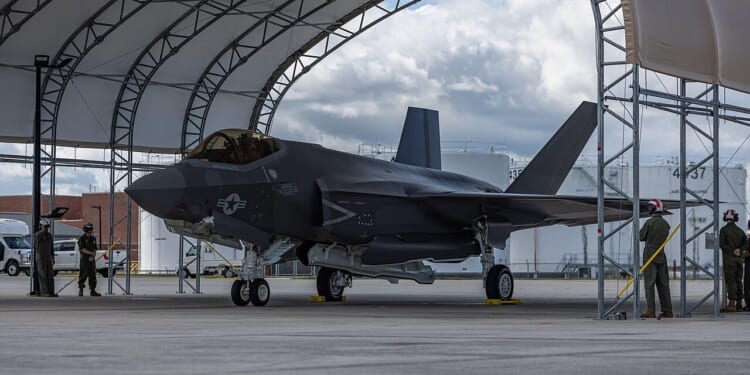The F-35C still retains significant advantages over the J-35. But on a comprehensive level, China might have an edge.
China has passed an impressive milestone for its military. For the first time in history, Chinese fifth-generation warplanes have successfully taken off and landed on an indigenously produced Chinese aircraft carrier. The videos of the event, which occurred in perfect weather conditions, have gone viral, with Beijing’s supporters highlighting its significance.
The specific plane that China successfully launched and recovered from their carrier was the Shenyang J-35, which is believed to be China’s answer to the Lockheed Martin F-35C Lightning II warplane that the United States Navy utilizes aboard their carrier fleet. The planes share more than just a number; Chinese industrial espionage clearly influenced the J-35’s ultimate design. But could the Chinese plane actually outcompete its American inspiration if it came to an open battle? What would a match-up between the two fifth-gen aircraft really look like?
The F-35C vs. the J-35: A Head-to-Head Comparison
| Aircraft | F-35C (United States) | J-35 (China) |
| Year Introduced | 2019 | 2025 |
| Number Built | 102 | Unknown; ~10 |
| Length | 51.5 ft (15.7 m) | 56 ft 9 in (17.3 m) |
| Wingspan | 43 ft (13.1 m) | 37 ft 9 in (11.5 m) |
| Weight | ~70,000 lb (31,800 kg) | 61,729 lb (28,000 kg) |
| Engines | One Pratt & Whitney F135-PW-100 afterburning turbofan engine | Two Guizhou WS-21 afterburning turbofan engines |
| Top Speed | Mach 1.6 (~1,190 mph, 1,919 km/h) at altitude | Mach 1.8 (1,330 mph, 2,200 km/h) at altitude |
| Range | ~600 nmi (690 mi, 1,110 km) combat radius | ~675 nmi (~780 mi, ~1,250 km) combat radius |
| Service Ceiling | ~50,000 ft (15,000 m) | ~52,000 ft (16,000 m) |
| Loadout | One 25 mm GAU-22/A 4-barrel rotary cannon; 10 hardpoints (4 internal, 6 external); 18,000 lb (8,160 kg) total payload capacity | 12 hardpoints (6 internal, 6 external); 8,000 kg (18,000 lb) total payload capacity |
| Aircrew | 1 | 1 |
The two planes’ similarities immediately stand out. Of course, they both belong to the fifth-generation family of fighter jets. Both are intended to be carrier-based planes, meaning that they have been modified to withstand catapult-assisted takeoffs and arrested landings using a tailhook that catches arresting gear.
The F-35C, unlike its Marine Corps sibling, the F-35B, does not utilize a short takeoff and vertical landing (STOVL) capability. Instead, it is launched from an aircraft carrier with the assistance of a catapult, like other US Navy warplanes. The absence of STOVL capabilities also means that it can carry a heavier payload than the F-35B. For the same reasons, China did not engineer their fifth-generation carrier-based warplane, the J-35, to employ STOVL.
Both aircraft emphasize stealth, multirole capabilities (including air-to-air, air-to-ground, and electronic warfare), along with advanced avionics. Still, most experts believe that the F-35C benefits from a more mature program with extensive operational experience.
The J-35, on the other hand, represents China’s push to catch up to the Americans in naval aviation technology and is a relatively untested platform. In fact, critics have long accused the J-35 of being China’s “bootlegged” version of the American F-35. Given that Chinese cyber spies gained access to the F-35’s schematics way back in 2005, during a massive hack of the Pentagon known as “Titan Rain,” the similarities are almost certainly more than superficial.
What Might Happen in an F-35 vs. J-35 Dogfight?
In a direct head-to-head matchup, the J-35 would edge out the American F-35C on speed, with a claimed top speed of up Mach 1.8, potentially allowing the J-35 to engage (or disengage) faster in supersonic fights compared to the F-35C’s Mach 1.6. The F-35C relies upon a single powerful engine to provide superior thrust-to-weight in some scenarios. What’s more, the F-35C’s single, powerful engine prioritizes sustained performance over the raw speed that the J-35 relies upon. Then again, the J-35’s twin engines offer greater redundancy (and resiliency) which might prove advantageous for the Chinese in given contests with the American F-35C.
Despite belonging to an expeditionary force, the US F-35C has a smaller combat radius of less than 600 nautical miles than the J-35’s claimed radius of 730 nautical miles. Thus, the Chinese J-35 has potentially longer patrol times and can sustain strikes farther away from their carrier without refueling than the Americans can.
At the same time, the F-35C carries more internal fuel, though its real-world range depends on loadout and efficiency. The J-35, on the other hand, would likely require external tanks for extended missions—compromising its stealth capabilities.
Speaking of stealth, both planes are built for low observability. Experts assess, though, that the F-35C’s stealth tech is superior because it has more combat experience than does the J-35, with superior radar cross-section (RCS) reduction across frequencies due to US investment.
The J-35 incorporates similar features—likely obtained through espionage—but those features are likely less advanced than the Americans simply because the Chinese are behind the Americans in terms of the development and deployment of stealth tech. Still, observers should not put too much stock in this fact, given the increasing speed at which the Chinese are catching up to the Americans.
The F-35 Is Built to Be More than Just a Fighter Jet
The one area where many experts argue the F-35C flies high above the J-35 is in the American plane’s integrated sensor suite, including a 360-degree infrared coverage and real-time data sharing, enabling the F-35C to coordinate with other US and allied platforms in the same area of operation. It is unlikely that the J-35 has caught up to the F-35C in this way. Again, though, that could change quickly, given how rapidly China is advancing their higher-end military equipment.
In terms of payload, the two planes are comparable but the F-35C, thanks to its interoperability with allied militaries in Europe, the Mideast, and Asia, means that its munitions are more well-rounded than the Chinese munitions.
At the same time, however, the J-35’s six missile carrying capacity will allow for a more air-to-air focus—meaning that the J-35 might be a better dogfighter than the F-35C.
If that’s the case, then, things could get tricky for the F-35C, as the Chinese intend to engage the F-35C in a fight. Plus, with China’s plans to attack US assets in space and across cyberspace, they could seriously hinder the capabilities of the F-35C—which is essentially a networked, flying computer.
So, the F-35C still retains significant advantages over the J-35. But, on a comprehensive level, China might have an edge—in ways that could prove shocking for the American side.
About the Author: Brandon J. Weichert
Brandon J. Weichert is a senior national security editor at The National Interest. Recently, Weichert became the host of The National Security Hour on America Outloud News and iHeartRadio, where he discusses national security policy every Wednesday at 8pm Eastern. He is also a contributor at Popular Mechanics and has consulted regularly with various government institutions and private organizations on geopolitical issues. Weichert’s writings have appeared in multiple publications, including The Washington Times, National Review, The American Spectator, MSN, The Asia Times, and others. His books include Winning Space: How America Remains a Superpower, Biohacked: China’s Race to Control Life, and The Shadow War: Iran’s Quest for Supremacy. His newest book, A Disaster of Our Own Making: How the West Lost Ukraine is available for purchase wherever books are sold. He can be followed via Twitter @WeTheBrandon.
Image: Wikimedia Commons.


















